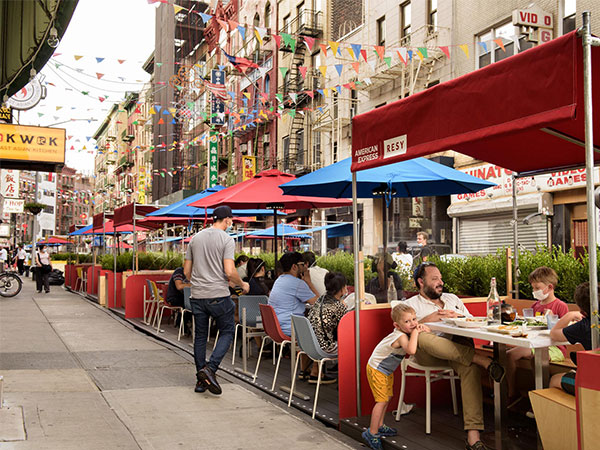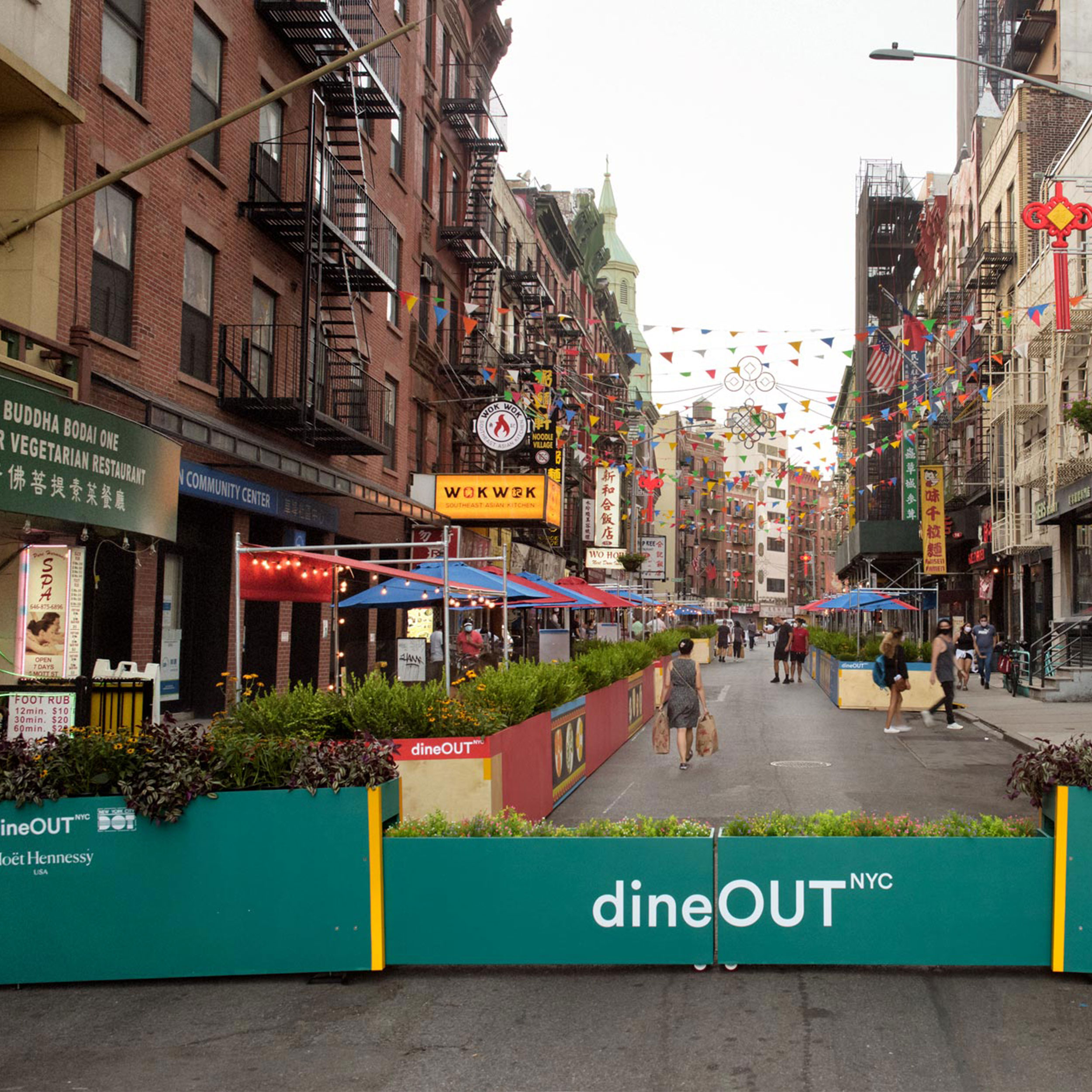James Conley surveys Keens Steakhouse’s six tables of outdoor seating on 36th Street in NYC. The tables sit six feet apart from each other, nestled against barricades (36 inches tall, 8 feet into the street, with reflectors against the flow of traffic). The air is sticky with summer heat and humidity. A delivery worker, his handcart stacked with produce, pulls to a stop. Conley politely excuses himself from the table to which he’s just served two very chilled glasses of Prosecco. The delivery driver can’t park in his normal place as there are tables there. Conley, formerly the beverage director, now the beverage-service-delivery-reception-director/patio captain/takeout sommelier receives the delivery mid-service and brings it to the kitchen, checking to make sure that the packed to-go order includes the requested bottle of Clos Erasmus.
Scenes such as these are now common. In an effort to open up revenue streams for restaurants, the city government unilaterally and swiftly allowed a massive expansion of outdoor dining. Public space formerly allotted to parked cars was snatched up by businesses, enclosed by barriers to city specifications, and populated by well-spaced tables.
Meanwhile, government statistics from early August indicated that restaurants across the five boroughs employed 193,000 fewer people than they did in February. When workers begin to return, they may find themselves wearing a few more hats than when they left.
As restaurants have pivoted to delivery and takeout models, selling cocktails to go through curbside windows, they’re doing their best to adapt to the frequently changing city regulations and recommendations. Keens (a staid steakhouse that dates to 1885) has been offering to-go meals as well, and its thirsty diners have shown a propensity to splurge on wine, even if it isn’t served by the sommelier. So far, some of the to-go sales include Turley Zin, Clos Erasmus and even a 1963 Port.
Outdoor dining will continue in the city until October 31; in early August, the mayor’s office announced that it would bring back the program next summer with the intent to make it a permanent yearly fixture, and possibly extend the duration of the program (it would currently run from June 1 to October 31). This re-allocation of public space for the lively activity of dining rather than the inactivity of parking is monumental: It’s the largest single shift of public space away from vehicles in years, and it’s the first concrete, likely permanent change to the function of restaurants due to the coronavirus.
However, not all restaurants would take advantage of outdoor dining in a post-COVID world. “If we have a rainy day, we do no business at all,” says Conley. “Decent weather, we do 40 or 45 covers. This is a restaurant that in July would normally be serving 800 people a day.”
NYC’s Chinatown partnership closed down Mott street to all daytime traffic to allow the installation of barricades and public seating for patrons of any nearby restaurant to use. the closure is part of Dineout NYC, an initiative created by the New York City Hospitality Alliance and the Rockwell Group to install similar “outdoor food courts” around the city. They’ve made the designs available on their webiste.


Many expensive restaurants are scaling back their prices and adjusting their menu during the pandemic. Even Copenhagen’s Noma functioned as an outdoor burger joint for more than a month during the summer. It’s changing wine lists, too: In New York, James Jusseaume at Aquavit in midtown, says, “We’re focusing on summery wines, whites and more accessible selections.” Downtown at L’Accolade, Clément Lapeyssonnie has found diners are “a bit more curious now. I can get them to try anything.”
There may be more seismic changes in the restaurant industry in the months to come. In early August, a host of top NYC restaurateurs, including Danny Meyer, Tom Colicchio and David Chang, announced their support of a “Safe and Just Reopening” plan— developed in part by One Fair Wage, an organization that has for years pushed for the elimination of the tipped minimum wage. The plan’s four pillars (eliminate the tipped minimum, allow tip-sharing between back- and front-of-house staff, payroll tax relief, and a 5 percent safe reopening surcharge) provide a potential roadmap for more fundamental changes in the American restaurant.
For sommeliers, this could impact a number of areas. While beverage directors and wine managers are generally salaried employees, assistant and floor sommeliers are often “tipped out.” If restaurants have to take on the additional labor costs involved in eliminating tipping, wine teams might shrink, squeezing the talent pool focused on wine or limiting access to management opportunities for eager young sommeliers. For restaurant management, the cost of a skilled sommelier used to be only the tipped minimum wage. When labor costs rise, the brass might be less keen on permitting such a narrow focus for the staff.
The indications of such a future might already be evident: Conley had years of experience as service director at Keens before moving to a wine-focused role, and credits that as the reason he was taken back on full-time: “I don’t know that somebody who was more strictly a wine specialist would have come back so soon.” At Aquavit, the restaurant had been open for a week and a half before management decided to bring back beverage director Chris Clark. Many, many more sommeliers remain on hold, even as New York City’s thoroughfares begin to resemble something reminiscent of the open plazas of old European cities. Today’s cosmopolitan diners are separated from the honking stream of traffic by a low barricade, under neon-colored tents that shelter diners from the rains of sudden thunderstorms—as long as there is little wind, which is never the case. Red wine can drink hot in the 90-plus-degree heat; go for a chilled white and bring your own umbrella, just in case.
Corey Warren is the Tastings Editor in addition to covering the wines of the Loire, Southern France, Argentina and South Africa.
This story appears in the print issue
of October 2020.
Like what you read? Subscribe
today.



















